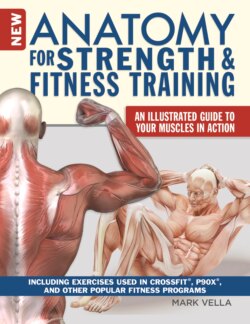Читать книгу New Anatomy for Strength & Fitness Training - Mark Vella - Страница 14
На сайте Литреса книга снята с продажи.
Your Body: Quick Guide to Joints and Movements
ОглавлениеKnowing and understanding the exercise movements, and at which joints they occur, is essential for being able to analyze an exercise. In this book, we have done the identification for you. In movement, while the articular system facilitates movement (initiated by the voluntary motor nerves), the skeletal system offers a series of levers upon which the muscles act, pulling on these levers at attachment points called insertions. When performing a movement, a combination of nerve stimulation and muscular contraction facilitates the movement that occurs at the synovial (free-moving joints). For example, when doing a bicep curl, the weight rises because the angle of the elbow joint closes, as the bicep muscle, which is attached from the upper arm bones onto the radius and ulna, shortens in contraction, thereby lifting the forearm. Most joint movements are common names, applying to most major joints—for example, flexion and extension—but there are some movements that only occur at specific joints, such as ankle plantarflexion and dorsiflexion.
Joint movements
The knee joint is the largest, the hip joint is the strongest, and the shoulder is potentially the most unstable joint in the body.
• Shoulder horizontal adduction
• Shoulder horizontal abduction
• Shoulder circumduction
• Shoulder extension
• Shoulder flexion
• Shoulder adduction
• Shoulder abduction
• Elbow flexion
• Elbow extension
• Forearm pronation
• Forearm supination
• Wrist flexion
• Wrist extension
• Trunk flexion
• Trunk extension
• Spinal rotation
• Trunk lateral flexion
• Hip internal rotation
• Hip external rotation
• Hip flexion
• Hip extension
• Knee extension
• Knee flexion
• Ankle dorsiflexion
• Ankle plantarflexion
• Ankle inversion
• Ankle eversion
